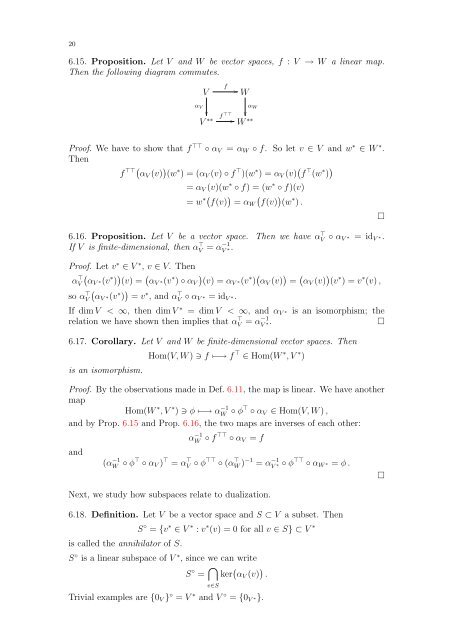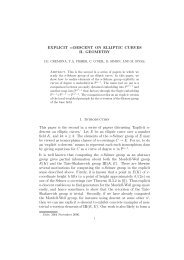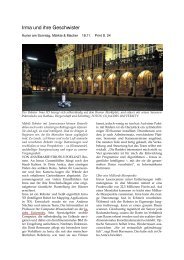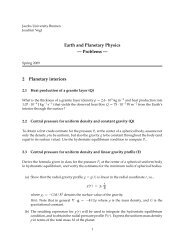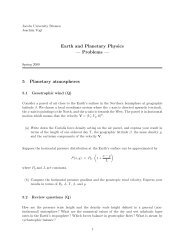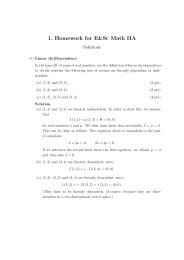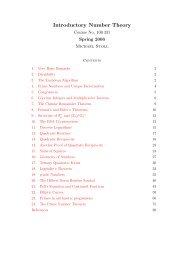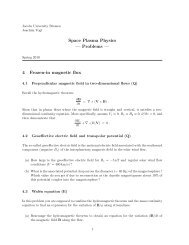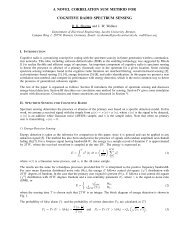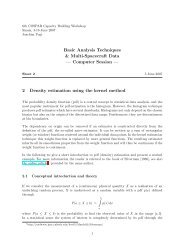Linear Algebra II (pdf, 500 kB)
Linear Algebra II (pdf, 500 kB)
Linear Algebra II (pdf, 500 kB)
You also want an ePaper? Increase the reach of your titles
YUMPU automatically turns print PDFs into web optimized ePapers that Google loves.
20<br />
6.15. Proposition. Let V and W be vector spaces, f : V → W a linear map.<br />
Then the following diagram commutes.<br />
αV<br />
V<br />
f<br />
<br />
W<br />
αW<br />
<br />
f ⊤⊤ <br />
∗∗ V <br />
∗∗ W<br />
Proof. We have to show that f ⊤⊤ ◦ αV = αW ◦ f. So let v ∈ V and w ∗ ∈ W ∗ .<br />
Then<br />
f ⊤⊤ αV (v) (w ∗ ) = (αV (v) ◦ f ⊤ )(w ∗ ) = αV (v) f ⊤ (w ∗ ) <br />
= αV (v)(w ∗ ◦ f) = (w ∗ ◦ f)(v)<br />
= w ∗ f(v) ∗<br />
= αW f(v) (w ) .<br />
6.16. Proposition. Let V be a vector space. Then we have α⊤ V<br />
If V is finite-dimensional, then α⊤ V<br />
Proof. Let v ∗ ∈ V ∗ , v ∈ V. Then<br />
α ⊤ V<br />
so α ⊤ V<br />
= α−1<br />
V ∗.<br />
<br />
◦ αV ∗ = idV ∗.<br />
<br />
αV ∗(v∗ ) (v) = αV ∗(v∗ <br />
) ◦ αV (v) = αV ∗(v∗ ) αV (v) = αV (v) (v ∗ ) = v ∗ (v) ,<br />
αV ∗(v∗ ) = v ∗ , and α ⊤ V<br />
◦ αV ∗ = idV ∗.<br />
If dim V < ∞, then dim V ∗ = dim V < ∞, and αV ∗ is an isomorphism; the<br />
relation we have shown then implies that α ⊤ V<br />
= α−1<br />
V<br />
∗. <br />
6.17. Corollary. Let V and W be finite-dimensional vector spaces. Then<br />
is an isomorphism.<br />
Hom(V, W ) ∋ f ↦−→ f ⊤ ∈ Hom(W ∗ , V ∗ )<br />
Proof. By the observations made in Def. 6.11, the map is linear. We have another<br />
map<br />
Hom(W ∗ , V ∗ ) ∋ φ ↦−→ α −1<br />
W ◦ φ⊤ ◦ αV ∈ Hom(V, W ) ,<br />
and by Prop. 6.15 and Prop. 6.16, the two maps are inverses of each other:<br />
and<br />
α −1<br />
W ◦ f ⊤⊤ ◦ αV = f<br />
(α −1<br />
W ◦ φ⊤ ◦ αV ) ⊤ = α ⊤ V ◦ φ ⊤⊤ ◦ (α ⊤ W ) −1 = α −1<br />
V ∗ ◦ φ⊤⊤ ◦ αW ∗ = φ .<br />
Next, we study how subspaces relate to dualization.<br />
6.18. Definition. Let V be a vector space and S ⊂ V a subset. Then<br />
is called the annihilator of S.<br />
S ◦ = {v ∗ ∈ V ∗ : v ∗ (v) = 0 for all v ∈ S} ⊂ V ∗<br />
S ◦ is a linear subspace of V ∗ , since we can write<br />
S ◦ = <br />
ker αV (v) .<br />
v∈S<br />
Trivial examples are {0V } ◦ = V ∗ and V ◦ = {0V ∗}.


